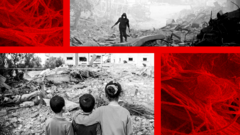As Israel's military operations continue to devastate Gaza, the unintended release of asbestos from damaged buildings is emerging as a serious health crisis. This toxic mineral, once common in construction, poses a latent danger through airborne fibers that can lead to serious diseases, including various forms of cancer. The United Nations Environment Programme (UNEP) indicates that up to 2.3 million tons of rubble could be contaminated with asbestos.
The pervasive use of asbestos roofing, particularly in Gaza’s urban refugee camps, underscores the risks faced by local residents. Professor Bill Cookson from the National Centre for Mesothelioma Research in London described the current situation as "very, very toxic," predicting long-term health issues that may persist for decades. Asbestos fibers, imperceptible to the naked eye, can accumulate in the lungs, often resulting in conditions like mesothelioma or asbestosis over many years. Dr. Ryan Hoy emphasizes the challenges of avoiding these inhalable particles in densely populated areas like Gaza, where about 2.1 million people live in crowded conditions.
Amid ongoing threats from military strikes, immediate concerns for survival overshadow the awareness of health risks from dust and asbestos. Organizations like Medical Aid for Palestinians highlight the lack of resources and knowledge among residents, rendering them vulnerable as they focus on immediate safety rather than long-term health. The absence of an effective cleanup strategy, necessary to mitigate these risks, poses an additional challenge, with past conflicts revealing asbestos presence in debris.
Globally, although many countries have banned asbestos, certain areas still experience its impact due to historical use. In the UK and Israel, asbestos was outlawed in buildings, yet its remnants persist in Gaza. Dr. Hoy warns of increased respiratory infections and other lung diseases linked to the high dust levels following airstrikes, drawing parallels to past disasters, like the fallout from the 9/11 attacks.
As reconstruction plans for Gaza emerge, experts stress the critical need for careful management to avoid disturbing the rubble laden with harmful asbestos. The eventual cleanup could take decades and significant financial investment, raising concerns about the health implications for those who have already faced immense trauma. The health crisis from asbestos may ultimately overshadow casualties from the conflict, highlighting the urgent need for awareness and preventative measures in war-torn regions.



















